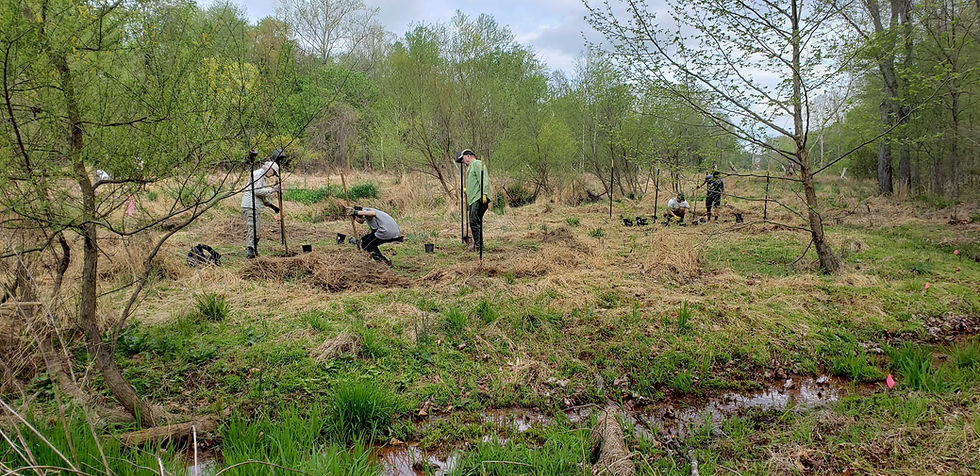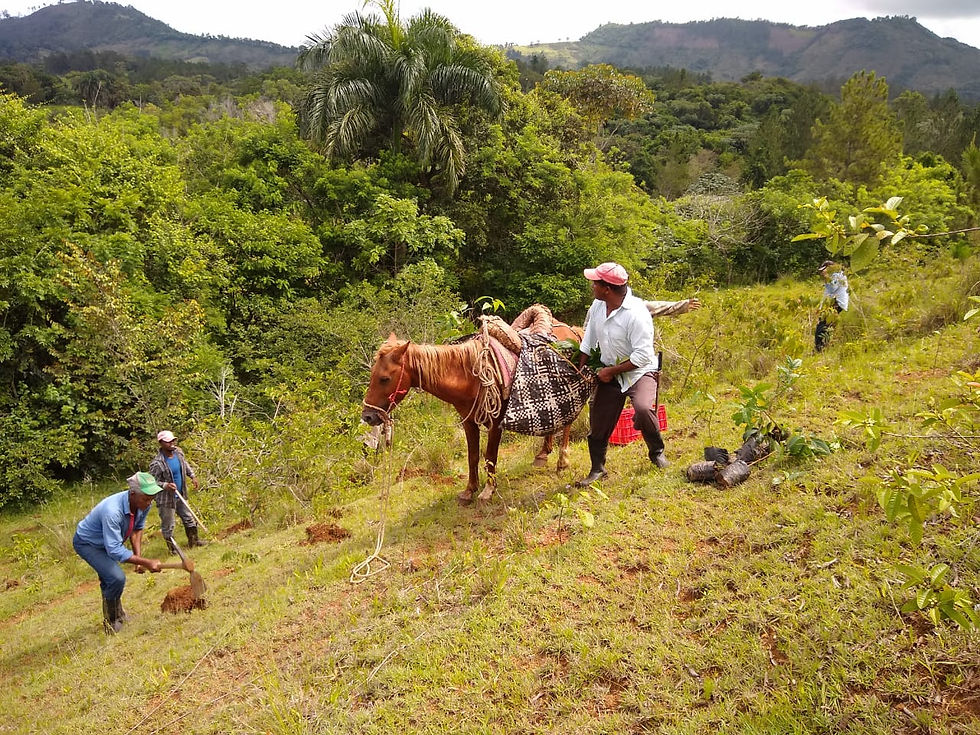Northern Virginia, Hispaniola, and Panama - What's The Connection?
- Matt Bright
- Oct 3, 2023
- 4 min read
We have a growing need for preservation as a tool to protect our native plants and their habitats, not just here in the DC area, but globally -- and in particular two international areas we are now working in: the island of Hispaniola, and in northwestern Panama with the Naso people.
Locally, we have begun building what we term "habitat refuges" in local parks where we are working with volunteers, Fairfax County Park Authority ecologists, and our own staff to better protect existing native vegetation from deer herbivory and antler rub as well as our own plantings. These habitat refuges are larger fenced areas (ranging from 12 to 30 ft in diameter) that we plant densely with trees, shrubs, and herbaceous plants. The metal fencing allows free access to birds, insects, small mammals, and amphibians, but protects them from deer overabundance that thins out canopy species, destroys fruit and seed set from native shrubs, and tracks in many invasive species.

Volunteers planting Habitat Refuge plantings along Dewey's Creek in Prince William County, Virginia in Spring 2023.
While we intend to plant a number of these habitat refuges, a significant portion of the ecological benefits comes from the preservation of existing native vegetation and the native seeds already residing in the seedbank. By removing stressors from the landscape (in this case, primarily heavy deer browse on tree and shrub seedlings and herbaceous plants, and antler rub on saplings) we can allow the extant natural plant community to heal itself. Where we find gaps in the kinds of plant diversity we expect for a given natural plant community, we will use our local-ecotype plants from our Wild Plant Nursery to fill in the gaps.
In the Dominican Republic, on the island of Hispaniola, much of our efforts with our Tree Bank Hispaniola program have been focused on preservation already. We operate a Credit Reserve system where small-holder farmers can enroll forested parcels on property they own in a conservation easement in exchange for access to low-interest loans. Lack of access to credit is a crucial problem for small-holder farmers in developing economies, and this program has been popular with community members in and around Los Cerezos, and has helped to drive some economic growth for members there.
We also purchased a tract of land outright, our Reserva, which contains more than 20 acres of forested land, permanently protecting the plants and habitat there.

A reforestation planting of locally grown, native trees at our Tree Bank Hispaniola Reserva. Mules and horse take over where our pick up truck can't go! In the red hat and white shirt is Manolo, one of our Tree Bank Hispaniola Co-Directors.
We are also now embarking on a project, called Tree Bank Panama, in northwestern Panama in cooperation with the indigenous Naso people. The biggest threats to the relatively intact and diverse forests in their region is poaching. Working with members of that community we are funding construction of a watch tower to reduce poaching in these recently-recognized indigenous region located near the border with Costa Rica. Poaching not only harms the local wildlife (our local contact reports rare Harpy Eagle sightings -- Panama's national bird! -- among the 600 known species of birds native to the region), but also damages plant communities as poachers cut carelessly through underbrush and disturb sensitive areas.

Looking our towards the Mirador del jaguar (Cave of the Jaguar), a sacred site for the Naso of the Siey Kjing community, from our project area in Panama.
As we have in the Dominican Republic, we plan to work long-term with the Naso people to learn more about how we can best collaborate and protect native plants and the wildlife that depends on them in the region. Our expansion to Panama does not signal an end to our work in the Dominican Republic -- far from it! Our continued interest in conservation in the neotropics is fuelled by our understanding of interconnectivity both in ecological terms (the Dominican Republic and Panama are both destinations for migratory bird species that spend their summers here in Northern Virginia) but also in social terms. That is, recognizing our place in the natural world as humans and that we have a duty to ourselves, to each other, to future generations, and to the other species we have evolved with to be better stewards to our natural lands and waters.
That stewardship often calls us to "do something" and there are many things we can do, at home, on our shared public lands, and abroad that can help us heal our lands: removing invasives, replanting native plants, and better protecting native plants that are already there. We also must foster a patient and humble spirit that allows us to learn from each other and adopt techniques from across the globe and see how we can best apply those techniques. We're doing that now by adapting Miyawaki methods from Asia and applied nucleation strategies from Central America to our practice here in the Northern Virginia. And we've brought our own thoughts and techniques on native plant restoration and synthesized them with local expertise in the Dominican Republic. We're excited to learn and share with our new partners in Panama and will certainly share what we learn with our colleagues, volunteers, and members at home.
Written by Matt Bright
Earth Sangha's Executive Director


























Earth Sangha's vision fuses Virginia refuges with Hispaniola easements and Panama sentinels into a テトリスTetris grid of global green, rotating threats into cleared lines of native revival triumphs.
شيخ روحاني
رقم شيخ روحاني
الشيخ الروحاني
الشيخ الروحاني
شيخ روحاني سعودي
رقم شيخ روحاني
شيخ روحاني مضمون
Berlinintim
Berlin Intim
جلب الحبيب
Shopping for abayas online has completely changed how I update my wardrobe, there’s such a wide selection of elegant, modest styles now! Whether you're looking for something simple, luxurious, or suitable for Umrah and prayer, online stores really offer something for every occasion. I love how easy it is to compare designs and find exactly what fits my style.
I really appreciate the holistic approach to conservation described here, especially the combination of creating habitat refuges locally and supporting preservation efforts internationally. It's fascinating how methods used in Northern Virginia can parallel projects on Hispaniola and in Panama. As someone who enjoys simulation games like Bitlife , where choices impact future outcomes, I'm reminded how real-life actions—like reducing deer pressures or supporting local farmers—can shape the long-term health of ecosystems.
This is such an inspiring initiative! Creating habitat refuges is a smart and sustainable way to protect native ecosystems both locally and globally. Just like Excavator Air Filters help protect machinery from environmental damage and extend their performance in rugged terrain, these habitat refuges act as a protective filter for fragile plant life against external threats like deer and invasive species. Keep up the amazing work!